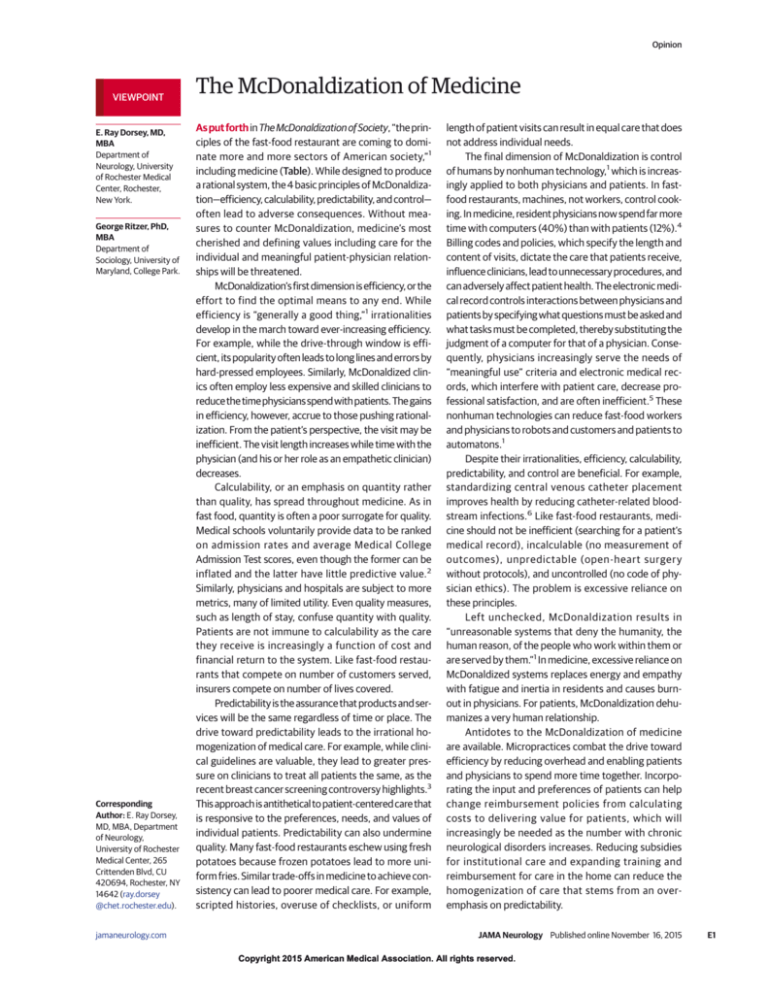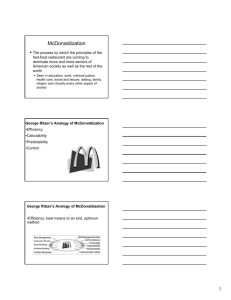
Opinion
VIEWPOINT
E. Ray Dorsey, MD,
MBA
Department of
Neurology, University
of Rochester Medical
Center, Rochester,
New York.
George Ritzer, PhD,
MBA
Department of
Sociology, University of
Maryland, College Park.
Corresponding
Author: E. Ray Dorsey,
MD, MBA, Department
of Neurology,
University of Rochester
Medical Center, 265
Crittenden Blvd, CU
420694, Rochester, NY
14642 (ray.dorsey
@chet.rochester.edu).
jamaneurology.com
The McDonaldization of Medicine
As put forth in The McDonaldization of Society, “the principles of the fast-food restaurant are coming to dominate more and more sectors of American society,”1
including medicine (Table). While designed to produce
a rational system, the 4 basic principles of McDonaldization—efficiency, calculability, predictability, and control—
often lead to adverse consequences. Without measures to counter McDonaldization, medicine’s most
cherished and defining values including care for the
individual and meaningful patient-physician relationships will be threatened.
McDonaldization’s first dimension is efficiency, or the
effort to find the optimal means to any end. While
efficiency is “generally a good thing,”1 irrationalities
develop in the march toward ever-increasing efficiency.
For example, while the drive-through window is efficient, its popularity often leads to long lines and errors by
hard-pressed employees. Similarly, McDonaldized clinics often employ less expensive and skilled clinicians to
reduce the time physicians spend with patients. The gains
in efficiency, however, accrue to those pushing rationalization. From the patient’s perspective, the visit may be
inefficient. The visit length increases while time with the
physician (and his or her role as an empathetic clinician)
decreases.
Calculability, or an emphasis on quantity rather
than quality, has spread throughout medicine. As in
fast food, quantity is often a poor surrogate for quality.
Medical schools voluntarily provide data to be ranked
on admission rates and average Medical College
Admission Test scores, even though the former can be
inflated and the latter have little predictive value.2
Similarly, physicians and hospitals are subject to more
metrics, many of limited utility. Even quality measures,
such as length of stay, confuse quantity with quality.
Patients are not immune to calculability as the care
they receive is increasingly a function of cost and
financial return to the system. Like fast-food restaurants that compete on number of customers served,
insurers compete on number of lives covered.
Predictability is the assurance that products and services will be the same regardless of time or place. The
drive toward predictability leads to the irrational homogenization of medical care. For example, while clinical guidelines are valuable, they lead to greater pressure on clinicians to treat all patients the same, as the
recent breast cancer screening controversy highlights.3
This approach is antithetical to patient-centered care that
is responsive to the preferences, needs, and values of
individual patients. Predictability can also undermine
quality. Many fast-food restaurants eschew using fresh
potatoes because frozen potatoes lead to more uniform fries. Similar trade-offs in medicine to achieve consistency can lead to poorer medical care. For example,
scripted histories, overuse of checklists, or uniform
length of patient visits can result in equal care that does
not address individual needs.
The final dimension of McDonaldization is control
of humans by nonhuman technology,1 which is increasingly applied to both physicians and patients. In fastfood restaurants, machines, not workers, control cooking. In medicine, resident physicians now spend far more
time with computers (40%) than with patients (12%).4
Billing codes and policies, which specify the length and
content of visits, dictate the care that patients receive,
influence clinicians, lead to unnecessary procedures, and
can adversely affect patient health. The electronic medical record controls interactions between physicians and
patients by specifying what questions must be asked and
what tasks must be completed, thereby substituting the
judgment of a computer for that of a physician. Consequently, physicians increasingly serve the needs of
“meaningful use” criteria and electronic medical records, which interfere with patient care, decrease professional satisfaction, and are often inefficient.5 These
nonhuman technologies can reduce fast-food workers
and physicians to robots and customers and patients to
automatons.1
Despite their irrationalities, efficiency, calculability,
predictability, and control are beneficial. For example,
standardizing central venous catheter placement
improves health by reducing catheter-related bloodstream infections.6 Like fast-food restaurants, medicine should not be inefficient (searching for a patient’s
medical record), incalculable (no measurement of
outcomes), unpredictable (open-heart surgery
without protocols), and uncontrolled (no code of physician ethics). The problem is excessive reliance on
these principles.
Left unchecked, McDonaldization results in
“unreasonable systems that deny the humanity, the
human reason, of the people who work within them or
are served by them.”1 In medicine, excessive reliance on
McDonaldized systems replaces energy and empathy
with fatigue and inertia in residents and causes burnout in physicians. For patients, McDonaldization dehumanizes a very human relationship.
Antidotes to the McDonaldization of medicine
are available. Micropractices combat the drive toward
efficiency by reducing overhead and enabling patients
and physicians to spend more time together. Incorporating the input and preferences of patients can help
change reimbursement policies from calculating
costs to delivering value for patients, which will
increasingly be needed as the number with chronic
neurological disorders increases. Reducing subsidies
for institutional care and expanding training and
reimbursement for care in the home can reduce the
homogenization of care that stems from an overemphasis on predictability.
(Reprinted) JAMA Neurology Published online November 16, 2015
Copyright 2015 American Medical Association. All rights reserved.
E1
Opinion Viewpoint
Table. Dimensions of McDonaldization of Medicine
Example
Dimension
Description
Fast Food
Medicine
Efficiency
Choosing the optimal
means to achieve
a given end
Drive-through window, limited
menu, self-ordering register,
finger foods, customers clear
their table
Minute clinics, broader use
of medical assistants, robotic
surgery, brief visits with
physicians, patients complete
questionnaires
Calculability
Calculating, counting, and
quantifying means and ends,
with quantity serving as a
surrogate for quality
Big Mac, supersize options,
No. of hamburgers sold, precise
measurement of hamburger size
(9.843 cm)
“Big Med,” medical school
rankings, RVUs to measure
productivity, ICD-10, length
of stay, 30-d readmission rates
Predictability
Services and products being
very similar from one time
and place to another time
and place
Extensive use of logos,
standardized appearance of
stores, use of frozen products,
assembly-line food production,
scripted interaction with
customers
Extensive use of logos,
standardized order sets,
checklists and templates,
clinical pathways, scripted
histories and physicals
Control
Increased control of humans
through use of nonhuman
technology
Factory farms of chicken and
cattle, hormone-treated animals,
precut and preprepared food,
automated soft-drink dispenser,
uncomfortable chairs
Billing codes, electronic
medical record, debt burden,
formularies, utilization
review
Control by nonhuman technologies can be mitigated by limiting the size of bureaucracies, ensuring electronic medical records
improve care, and reducing the financial burden of young physicians. Enforcement of antitrust laws can limit the size and scope of
bureaucracies, which often have an irresistible drive for control, and
ensure consumer choice. Vendors of electronic medical records that
benefit from taxpayer incentives must be accountable to produce
technology that facilitates better care and not simply more control. Finally, increasing residency compensation or reducing training would enable greater autonomy for future physicians to potentially choose fields that are more aligned with societal interests.
Neurology is not immune from McDonaldization. For example,
the mission of the American Board of Psychiatry and Neurology is
not to serve the public or the profession but “to develop and provide valid and reliable procedures for certification and maintenance of certification.”7 Rather than burden psychiatrists and neurologists with onerous requirements of uncertain value, the board
could promote public service and professional ideals by asking its
members to engage in activities to improve the health of society. Such
work could be caring for those with limited means, helping ensure
the neurological well-being of young athletes, or preparing families
for the increasing burden of Alzheimer disease. If we are going to
count in medicine, let it not be the number of medical records reviewed but rather the number of lives touched, minds stimulated,
and hearts moved. The struggle against the McDonaldization of
medicine will be both increasingly necessary and ennobling.
2. Julian ER. Validity of the Medical College
Admission Test for predicting medical school
performance. Acad Med. 2005;80(10):910-917.
ARTICLE INFORMATION
Published Online: November 16, 2015.
doi:10.1001/jamaneurol.2015.3449.
Conflict of Interest Disclosures: None reported.
Additional Contributions: Denzil Harris, BA,
University of Rochester School of Medicine and
Dentistry, Rochester, New York, assisted in the
preparation of the manuscript and John Markman,
MD, University of Rochester Medical Center,
Rochester, New York, provided thoughtful critique;
they received no compensation.
Abbreviations: ICD-10, International
Statistical Classification of Diseases
and Related Health Problems, Tenth
Revision; RVUs, relative value units.
3. Hartzband P, Groopman J. Keeping the patient in
the equation: humanism and health care reform.
N Engl J Med. 2009;361(6):554-555.
4. Block L, Habicht R, Wu AW, et al. In the wake of
the 2003 and 2011 duty hours regulations, how do
internal medicine interns spend their time? J Gen
Intern Med. 2013;28(8):1042-1047.
5. Freidberg MW, Chen PG, Van Busum KR, et al.
Factors affecting physician professional satisfaction
and their implications for patient care, health
systems, and health policy. http://www.rand.org
/pubs/research_reports/RR439.html. Accessed July
14, 2014.
6. Pronovost P, Needham D, Berenholtz S, et al. An
intervention to decrease catheter-related
bloodstream infections in the ICU. N Engl J Med.
2006;355(26):2725-2732.
7. American Board of Psychiatry and Neurology,
Inc. Mission and history. http://www.abpn.com
/about/mission-and-history/. Accessed September
3, 2015.
REFERENCES
1. Ritzer G. The McDonaldization of Society. 7th ed.
Thousand Oaks, CA: Sage; 2013.
E2
JAMA Neurology Published online November 16, 2015 (Reprinted)
Copyright 2015 American Medical Association. All rights reserved.
jamaneurology.com









